Arabica coffee: breeding secrets and home care
Coffee is a well-known drink made from coffee beans. Such grains are collected from trees growing in warm and hot regions of the planet: South America, Africa. Recently, more and more amateur flower growers began to pay attention to the exotic and grow coffee trees at home. After a certain period, wood Arabica coffee, home care for which must be correct, will give fruit.
Content:
Characteristics of Arabica coffee
Coffee is evergreen wood or bush, belongs to the Marev family. Its branches are long, not very branching, flexible. The leaves are opposite. Their shape is oval, oblong, pointed at the end. Painted in a bright green tone, wavy along the edges, well-defined veins, the surface of the leaf is glossy.
At home, Arabica coffee grows up to 1 meter.
His crown is dense, so the plant always has decorative view... The root system is small, so coffee grows well in a pot. The flowers resemble stars in shape, their size is small, the petals are painted in a white tone, collected in 3-6 pieces in inflorescences.
Blooming of buds begins in spring, after 6 months the fruits ripen. Coffee trees are quite unpretentious plants and grow and develop well at home.
Plant care
It is recommended to place a coffee tree or bush in a well-lit room; direct sunlight should not fall on the leaves. In the summer, you can move it to the balcony or take it to the country house and place it in partial shade. And in the winter months, additional lighting is sometimes necessary. It should also be borne in mind that the plant does not like the frequent change of habitat, therefore it is not recommended to constantly transfer it from room to room.
Temperature range:
- The ambient temperature should be between 23-25 degrees during the summer months.
- In winter, the room should not be less than 15 degrees.
- It is better not to place the bush near heating appliances, since dry air and constant high temperature will lead to foliage falling off.
Coffee is quite demanding on moisture, especially during development and flowering... Therefore, in the spring watering produce regularly, controlling soil moisture.
In the autumn months, they begin to reduce watering so that in winter they water only when the top layer of soil in the pot dries out.
Water for irrigation must be prepared, running water from the tap is not suitable. To do this, a flask or bottle of water is collected in 1-2 days and settled. When watering, it should be at room temperature. Excess moisture will collect in the pallet and must be drained.
Plant feeding:
- For good plant development and regular flowering and fruiting, it is recommended to feed the bushes mineral fertilizers.
- You can use complex dressings that are sold in gardening stores.
Young bushes or coffee trees are recommended transplant annually in a container with a large volume. Adult plants are transplanted as needed, but at least once every 3 years. The soil is selected slightly acidic, light, so that air flows to the roots. IN pruning the plant does not need, its branches grow quite correctly and beautifully. If desired, you can form a bush or tree by cutting off the lower shoots and pinching the upper ones.
Reproduction of Arabica coffee
Coffee multiplies with the help seed and cuttings... Seeds are green coffee beans. For propagation, it is recommended to take fresh, recently harvested seeds. They can be taken from a tree or purchased from a store. The shell of the seed is strong enough for germination to take place successfully, it is necessary to expose the grains stratification with acid or just gently cut the grain. After that you can endure the seeds in a stimulating solution.
For planting, light and loose soil is taken, the grains are immersed to a depth of 2 cm.
If the room where the seedlings will be located is cool, then it is necessary to cover the soil with foil or glass. At normal temperatures, the pot is exposed to the sunny side and the soil is regularly moistened. The first shoots should appear in 3-4 weeks. Young plants can be planted only after 10 months, when the root system gets stronger.
Plant propagation:
- Cuttings prepared in spring. For this, the upper shoots are cut, the size of which should be 10-15 cm. The cut is made obliquely, stepping back 2 cm from the lower bud.
- A substrate is prepared from sand and peat and placed in a container where cuttings will take root.
- To remove less moisture, it is necessary to cut off half of the leaves on the cut branch, but you cannot remove everything.
- The cuttings are buried in the prepared substrate and covered with polyethylene or a jar, creating greenhouse conditions.
- The temperature for good rooting should be kept within 25-27 degrees.
- The humidity should be high.
The sign of correct and successful rooting is new shoots, which should start growing in 4-5 weeks. When 2-3 new leaves are formed on the shoots, young coffee bushes can be planted in separate pots with fertile, nutritious soil. They are deepened to the same level as when rooting. By propagating coffee using cuttings, flowering can be obtained in the first year. To strengthen the root system and the bush itself, it is recommended to remove them.
Diseases and pests
Coffee trees are quite resistant to diseases and pests... All manifestations of ailments are mainly associated with improper care of the plant. For example, if the leaves begin to dry, this is an indicator that the plant is standing close to the heater or the air around it is dry. It is necessary to rearrange the pot, and humidify the air with a spray bottle or humidifier.
Of the pests, the scabbard is most often found. It appears on the leaves as brown specks. To remove it, you need process all leaves with special insecticides.
More information can be found in the video.




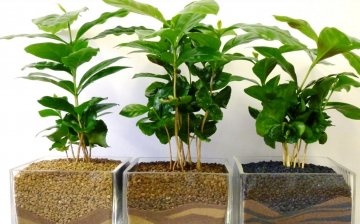
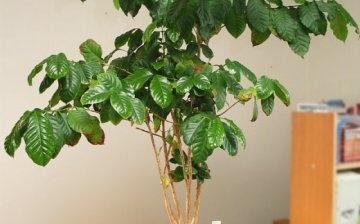
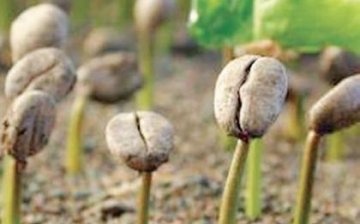






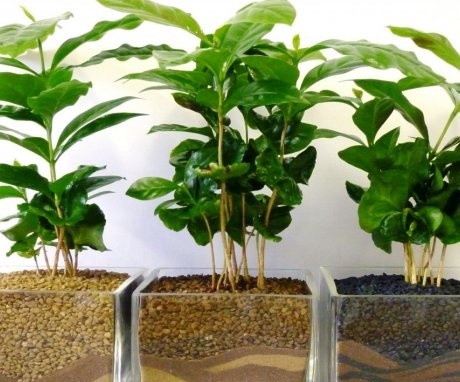
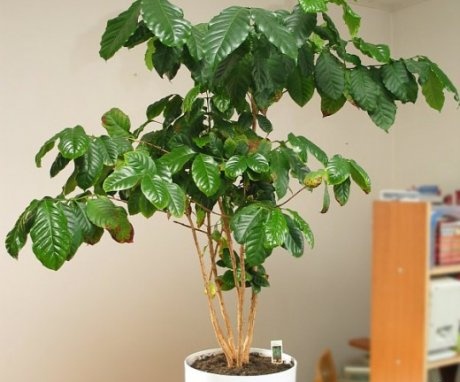
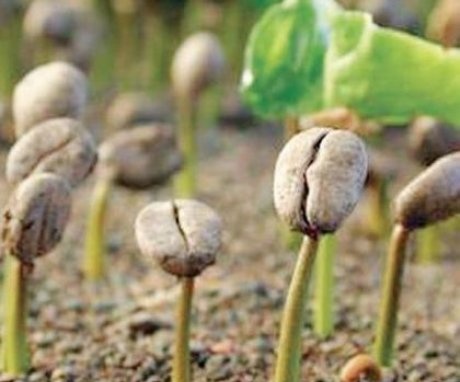

Freshly roasted coffee
second: roastcoffee